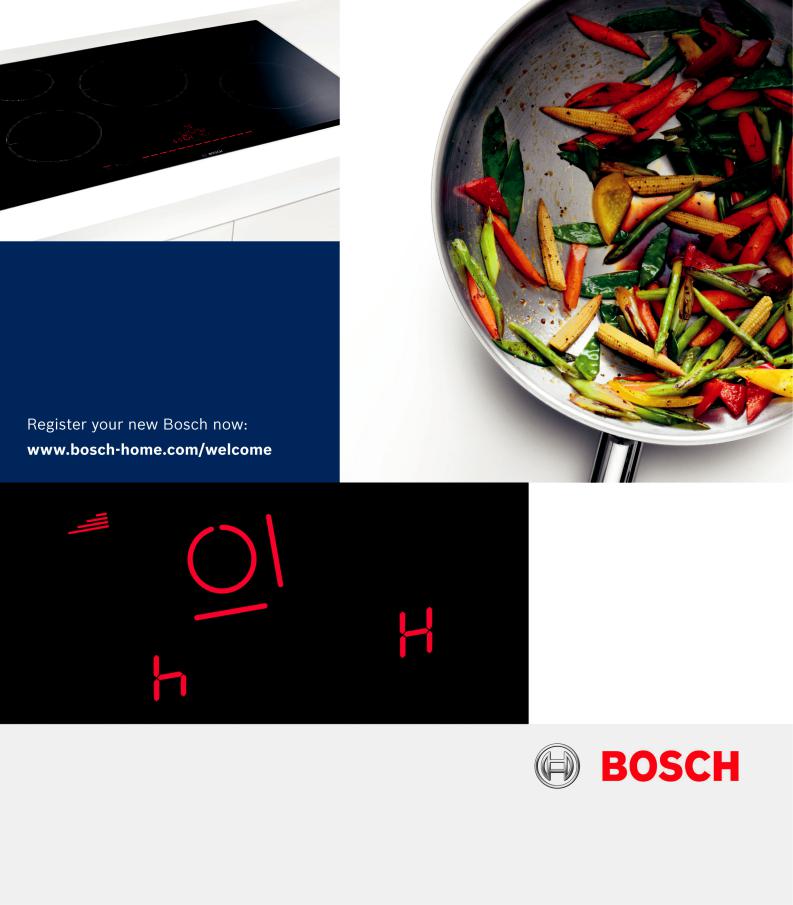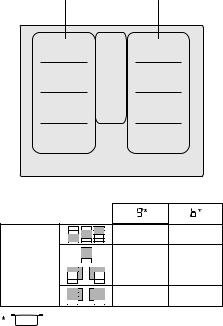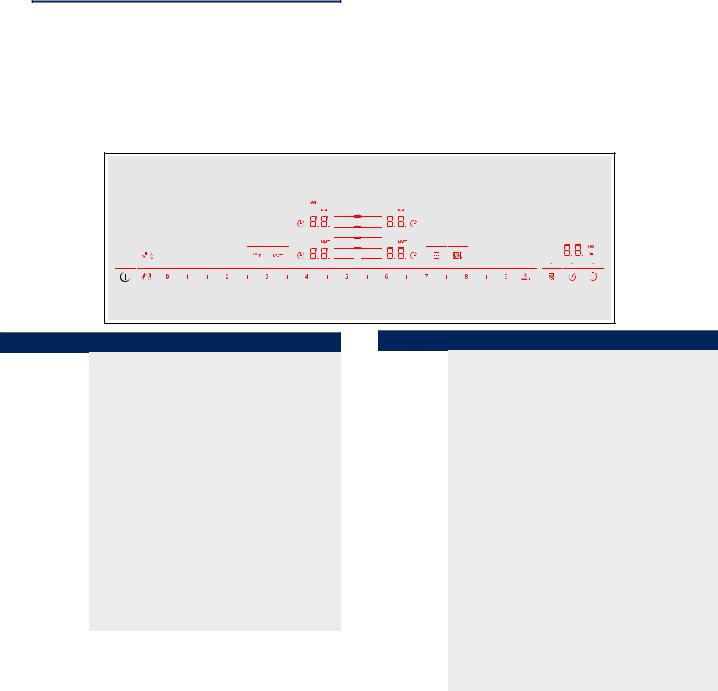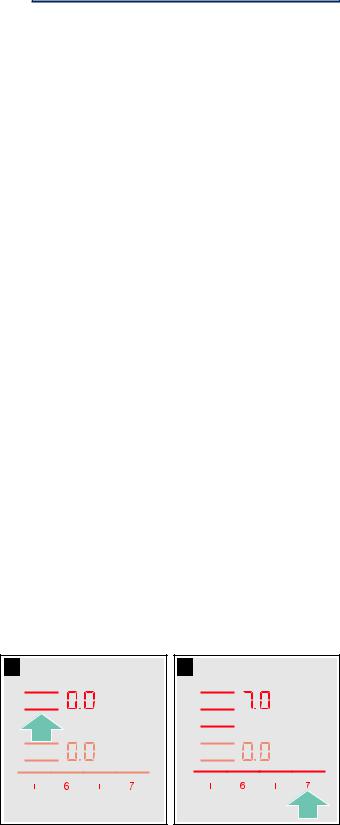Bosch PXY675DC1E Service Manual

Hob
PXY...D...
[en] Instruction manual

: |
: |
: :


 : :
: :
: :
,(&
2 |
Ø = cm |

Table of contents
8 Intended use . . . . . . . . . . . . . . . . . . . . . . . . . . . . . 4
( Important safety information . . . . . . . . . . . . . . . 5
] Causes of damage . . . . . . . . . . . . . . . . . . . . . . . . 6
Overview . . . . . . . . . . . . . . . . . . . . . . . . . . . . . . . . . . . 6
7 Environmental protection . . . . . . . . . . . . . . . . . . 7
Energy-saving advice . . . . . . . . . . . . . . . . . . . . . . . . . . 7 Environmentally-friendly disposal . . . . . . . . . . . . . . . . . 7
f Induction cooking . . . . . . . . . . . . . . . . . . . . . . . . 7
Advantages of induction cooking. . . . . . . . . . . . . . . . . 7 Cookware. . . . . . . . . . . . . . . . . . . . . . . . . . . . . . . . . . . 7
* Getting to know your appliance . . . . . . . . . . . . . 9
The control panel . . . . . . . . . . . . . . . . . . . . . . . . . . . . . 9 The hotplates . . . . . . . . . . . . . . . . . . . . . . . . . . . . . . . 10 Residual heat indicator. . . . . . . . . . . . . . . . . . . . . . . . 10
1 Operating the appliance . . . . . . . . . . . . . . . . . . 11
Switching the hob on and off . . . . . . . . . . . . . . . . . . . 11 Setting a hotplate . . . . . . . . . . . . . . . . . . . . . . . . . . . . 11 Chef's recommendations . . . . . . . . . . . . . . . . . . . . . . 11
| Flex Zone . . . . . . . . . . . . . . . . . . . . . . . . . . . . . . 14
Advice on using cookware. . . . . . . . . . . . . . . . . . . . . 14 As two independent hotplates . . . . . . . . . . . . . . . . . . 14 As a single hotplate . . . . . . . . . . . . . . . . . . . . . . . . . . 14
u Move function. . . . . . . . . . . . . . . . . . . . . . . . . . . 15
Activation . . . . . . . . . . . . . . . . . . . . . . . . . . . . . . . . . . 15 Deactivating . . . . . . . . . . . . . . . . . . . . . . . . . . . . . . . . 15
} FlexPlus Zone. . . . . . . . . . . . . . . . . . . . . . . . . . . 16
Notes regarding cookware. . . . . . . . . . . . . . . . . . . . . 16 Activation . . . . . . . . . . . . . . . . . . . . . . . . . . . . . . . . . . 16 Deactivating . . . . . . . . . . . . . . . . . . . . . . . . . . . . . . . . 16
O Time-setting options . . . . . . . . . . . . . . . . . . . . . 17
Programming the cooking time . . . . . . . . . . . . . . . . . 17 The kitchen timer . . . . . . . . . . . . . . . . . . . . . . . . . . . . 17 Stopwatch function. . . . . . . . . . . . . . . . . . . . . . . . . . . 18
v PowerBoost function . . . . . . . . . . . . . . . . . . . . . 18
Activating . . . . . . . . . . . . . . . . . . . . . . . . . . . . . . . . . . 18 Deactivating . . . . . . . . . . . . . . . . . . . . . . . . . . . . . . . . 18
x ShortBoost function . . . . . . . . . . . . . . . . . . . . . 19
Recommendations for use . . . . . . . . . . . . . . . . . . . . . 19 Activating . . . . . . . . . . . . . . . . . . . . . . . . . . . . . . . . . . 19 Deactivating . . . . . . . . . . . . . . . . . . . . . . . . . . . . . . . . 19
en
z Keep warm function . . . . . . . . . . . . . . . . . . . . . . 19
Activating . . . . . . . . . . . . . . . . . . . . . . . . . . . . . . . . . .19 Deactivating . . . . . . . . . . . . . . . . . . . . . . . . . . . . . . . .19
s Transferring settings . . . . . . . . . . . . . . . . . . . . . 20
Activation . . . . . . . . . . . . . . . . . . . . . . . . . . . . . . . . . .20
c Frying Sensor . . . . . . . . . . . . . . . . . . . . . . . . . . . 20
Advantages when frying . . . . . . . . . . . . . . . . . . . . . . .20 For frying with the frying sensor . . . . . . . . . . . . . . . . .20 Temperature settings . . . . . . . . . . . . . . . . . . . . . . . . .21 Table . . . . . . . . . . . . . . . . . . . . . . . . . . . . . . . . . . . . .21 Setting procedure . . . . . . . . . . . . . . . . . . . . . . . . . . . .23
A Childproof lock. . . . . . . . . . . . . . . . . . . . . . . . . . 23
Activating and deactivating the childproof lock . . . . .23 Childproof lock . . . . . . . . . . . . . . . . . . . . . . . . . . . . . .23
k Wipe protection . . . . . . . . . . . . . . . . . . . . . . . . . 24
b Automatic safety cut-out . . . . . . . . . . . . . . . . . . 24
Q Basic settings. . . . . . . . . . . . . . . . . . . . . . . . . . . 25
To access the basic settings: . . . . . . . . . . . . . . . . . . .26
[ Energy consumption indicator . . . . . . . . . . . . . 27
t Cookware check. . . . . . . . . . . . . . . . . . . . . . . . . 27
D Cleaning . . . . . . . . . . . . . . . . . . . . . . . . . . . . . . . 28
Hob. . . . . . . . . . . . . . . . . . . . . . . . . . . . . . . . . . . . . . .28 Hob surround . . . . . . . . . . . . . . . . . . . . . . . . . . . . . . .28
{ Frequently Asked Questions (FAQ) . . . . . . . . . 29
3 Trouble shooting . . . . . . . . . . . . . . . . . . . . . . . . 30
4 Customer service . . . . . . . . . . . . . . . . . . . . . . . . 31
E number and FD number . . . . . . . . . . . . . . . . . . . . .31
E Test dishes . . . . . . . . . . . . . . . . . . . . . . . . . . . . . 32
Additional information on products, accessories, replacement parts and services can be found at www.bosch-home.com and in the online shop
www.bosch-eshop.com
3

en Intended use
8Intended use
Read these instructions carefully. Please keep the instruction and installation manual, as well as the appliance certificate, in a safe place for later use or for subsequent owners.
Check the appliance after removing it from the packaging. If it has suffered any damage in transport, do not connect the appliance, contact the Technical Assistance Service and provide written notification of the damage caused, otherwise you will lose your right to any type of compensation.
This appliance must be installed according to the installation instructions included.
This appliance is intended for private domestic use and the household environment only. The appliance must only be used for the preparation of food and beverages. The cooking process must be supervised. A short cooking process must be supervised without interruption. Only use the appliance in enclosed spaces.
This appliance is intended for use up to a maximum height of 4000 metres above sea level.
Do not use covers. These can cause accidents, due to overheating, catching fire or materials shattering, for example.
Do not use inappropriate child safety shields or hob guards. These can cause accidents.
This appliance is not intended for operation with an external clock timer or a remote control.
This appliance may be used by children over the age of 8 years old and by persons with reduced physical, sensory or mental capabilities or by persons with a lack of experience or knowledge if they are supervised or are instructed by a person responsible for their safety how to use the appliance safely and have understood the associated hazards.
Children must not play with, on, or around the appliance. Children must not clean the appliance or carry out general maintenance unless they are at least 8 years old and are being supervised.
Keep children below the age of 8 years old at a safe distance from the appliance and power cable.
We advise that you exercise caution using or standing near an induction hob while it is in operation, if you wear a pacemaker or a similar medical device. Consult your doctor or the device manufacturer concenring its conformity or any possible incompatibilities,
4

(Important safety information
:Warning – Risk of fire!
■Hot oil and fat can ignite very quickly. Never leave hot fat or oil unattended. Never use water to put out burning oil or fat. Switch off the hotplate. Extinguish flames carefully using a lid, fire blanket or something similar.
■The hotplates become very hot. Never place combustible items on the hob. Never place objects on the hob.
■The appliance gets hot. Do not keep combustible objects or aerosol cans in drawers directly underneath the hob.
■The hob switches off automatically and can no longer be operated. It may switch on unintentionally at a later point. Switch off the circuit breaker in the fuse box. Contact the after-sales service.
:Warning – Risk of burns!
■The hotplates and surrounding area (particularly the hob surround, if fitted) become very hot. Never touch the hot surfaces. Keep children at a safe distance.
■The hotplate heats up but the display does not work. Switch off the circuit breaker in the fuse box. Contact the after-sales service.
■Metal objects on the hob quickly become very hot. Never place metal objects (such as knives, forks, spoons and lids) on the hob.
■After each use, always turn off the hob at the main switch. Do not wait until the hob turns off automatically after the pan is removed.
:Warning – Risk of electric shock!
■Incorrect repairs are dangerous. Repairs may only be carried out and damaged power cables replaced by one of our trained after-sales technicians. If the appliance is defective, unplug the appliance from the mains or switch off the circuit breaker in the fuse box. Contact the aftersales service.
■Do not use any high-pressure cleaners or steam cleaners, which can result in an electric shock.
Important safety information |
en |
■A defective appliance may cause electric shock. Never switch on a defective appliance. Unplug the appliance from the mains or switch off the circuit breaker in the fuse box. Contact the after-sales service.
■Cracks or fractures in the glass ceramic may cause electric shocks. Switch off the circuit breaker in the fuse box. Contact the after-sales service.
:Warning – Malfunction risk!
The hob is equipped with a fan in the lower section. If there is a drawer under the hob it should not be used to store small objects or paper, since they could damage the fan or interfere with the cooling if they are sucked into it.
There should be a minimum of 2 cm between the contents of the drawer and fan intake.
:Warning – Risk of injury!
■When cooking in a bain marie, the hob and cooking container could shatter due to overheating. The cooking container in the bain marie must not directly touch the bottom of the water-filled pot. Only use heatresistant cookware.
■Saucepans may suddenly jump due to liquid between the pan base and the hotplate. Always keep the hotplate and saucepan bases dry.
5

en Causes of damage
]Causes of damage
Caution!
■Rough pan bases may scratch the hob.
■Avoid leaving empty pots and pans on the hotplate. Doing so may cause damage.
■Do not place hot pans on the control panel, the indicator area, or the hob frame. Doing so may cause damage.
■Hard or pointed objects dropped on the hob may damage it.
■Aluminium foil and plastic containers will melt if placed on the hotplate while it is hot. The use of laminated sheeting is not recommended on the hob.
Overview
You will find the most frequently caused damage in the following table:
Damage |
Cause |
Measure |
Stains |
Boiled over food. |
Remove boiled over food immediately with a glass scraper. |
|
Unsuitable cleaning agent. |
Only use cleaning agents that are suitable for this type of hob. |
Scratches |
Salt, sugar and sand. |
Do not use the hob as a work surface or storage space. |
|
Cookware with rough bases scratch the hob. |
Check the cookware. |
Discolouration |
Unsuitable cleaning agent. |
Only use cleaning agents that are suitable for this type of hob. |
|
Pan abrasion. |
Lift pots and pans when moving them. |
Chips |
Sugar, food with a high sugar content. |
Remove boiled over food immediately with a glass scraper. |
|
|
|
6

7Environmental protection
In this section, you can find information about saving energy and disposing of the appliance.
Energy-saving advice
■Always use the correct lid for each pan. Cooking without a lid uses a lot more energy. Use a glass lid to provide visibility and avoid having to lift the lid.
■Use pans with flat bases. Bases that are not flat use a lot more energy.
■The diameter of the pan base must match the size of the hotplate. Please note: pan manufacturers usually provide the diameter for the top of the pan, which is usually larger than the diameter of the pan base.
■Use a small pan for small amounts of food. A large pan which is not full uses a lot of energy.
■Use little water when cooking. This saves energy and preserves all the vitamins and minerals in vegetables.
■Select the lowest power level to maintain cooking. If the power level is too high, energy is wasted.
Environmentally-friendly disposal
Dispose of packaging in an environmentally-friendly manner.
This appliance is labelled in accordance with European Directive 2012/19/EU concerning used electrical and electronic appliances (waste electrical and electronic equipment - WEEE). The guideline determines the framework for the return and recycling of used appliances as applicable throughout the EU.
Environmental protection |
en |
fInduction cooking
Advantages of induction cooking
Induction cooking is very different from traditional cooking methods, as heat builds up directly in the item of cookware. This offers numerous advantages:
■Saves time when boiling and frying.
■Saves energy.
■Easier to care for and clean. Spilled food does not burn on as quickly.
■Heat control and safety – the hob increases or decreases the heat supply as soon as the user changes the setting. The induction hotplate stops the heat supply as soon as the cookware is removed from the hotplate, without having to switch it off first.
Cookware
Only use ferromagnetic cookware for induction cooking, such as:
■Cookware made from enamelled steel
■Cookware made from cast iron
■Special induction-compatible cookware made from stainless steel.
To check whether your cookware is suitable for induction cooking, refer to the section on
~ "Cookware check".
To achieve a good cooking result, the ferromagnetic area on the base of the pan should match the size of the hotplate. If a hotplate does not detect an item of cookware, try placing it on another hotplate with a smaller diameter.
FP |
FP |
FP |
If the only hotplate being used is the flexible cooking zone, larger cookware that is particularly suited to this zone can be used. You can find information on positioning cookware in the section on ~ "Flex Zone".
7

en Induction cooking
Some induction cookware does not have a fully ferromagnetic base:
■If the base of the cookware is only partially ferromagnetic, only the area that is ferromagnetic will heat up. This may mean that heat will not be distributed evenly. The non-ferromagnetic area may not heat up to a sufficient temperature for cooking.
■The ferromagnetic area will also be reduced if the material from which the base of the cookware is made contains aluminium, for example. This may mean that the cookware will not become sufficiently hot or even that it will not be detected.
Unsuitable pans
Never use diffuser hobs or pans made from:
■common thin steel
■glass
■earthenware
■copper
■aluminium
Properties of the base of the cookware
The material(s) from which the base of the cookware is made can affect the cooking result. Using pots and pans made from materials that distribute heat evenly through them, such as stainless-steel pans with a threelayer base, saves time and energy.
Use cookware with a flat base; if the base of the cookware is uneven, this may impair the heat supply.
Absence of pan or unsuitable size
If no pan is placed on the selected hotplate, or if it is made of unsuitable material or is not the correct size, the power level displayed on the hotplate indicator will flash. Place a suitable pan on the hotplate to stop the flashing. If this takes more than 90 seconds, the hotplate will switch off automatically.
Empty pans or those with a thin base
Do not heat empty pans, nor use pans with a thin base. The hob is equipped with an internal safety system. However, an empty pan may heat up so quickly that the "automatic switch off" function may not have time to react and the pan may reach very high temperatures. The base of the pan could melt and damage the glass on the hob. In this case, do not touch the pan and switch the hotplate off. If it fails to work after it has cooled down, please contact the Technical Assistance Service.
Pan detection
Each hotplate has a lower limit for pan detection. This depends on the diameter of the ferromagnetic area of the cookware and the material from which its base is made. For this reason, you should always use the hotplate that best matches the diameter of the base of the pan.
8

Getting to know your appliance |
en |
*Getting to know your appliance
You can find information on the dimensions and power of the hotplates in~ Page 2
The control panel
Controls |
|
Displays |
|
# |
Main switch |
‹.‹ |
Operating status |
ã |
Select a hotplate |
|
|
0 1Ê2Ê...Ê8Ê9 |
Settings range |
|
|
á |
PowerBoost and ShortBoost function |
|
|
> |
Lock control panel for cleaning |
|
|
Š |
Childproof lock |
|
|
Û |
Keep warm function |
|
|
é |
Frying sensor |
|
|
è |
Flexible cooking zone |
|
|
ç |
Move function |
|
|
t |
Kitchen timer |
|
|
y |
Timer function |
|
|
x |
Kitchen timer |
|
|
Controls
When the hob heats up, the symbols for the controls available at this time light up.
Touching a symbol activates the respective function.
Notes
■The corresponding symbols for the controls light up depending on whether they are available.
The displays for the hotplates or the selected functions get brighter.
■Always keep the control panel clean and dry. Moisture can prevent it from working properly.
‚.‹- Š.‹ |
Heat settings |
|
|
•/œ |
Residual heat |
|
|
‹‹ |
Timer function |
|
|
Š |
Childproof lock |
|
|
> |
Lock control panel for cleaning |
|
|
y |
Programming the cooking time |
|
|
ö/ ô |
Timer displays |
|
|
›. |
PowerBoost function |
|
|
˜›. |
ShortBoost function |
|
|
è |
Flexible cooking zone |
|
|
é |
Frying sensor |
|
|
ô |
FlexPlus cooking zone |
|
|
£ |
Settings transfer |
|
|
÷ |
Energy consumption |
|
|
–© |
Keep warm function |
|
|
9

en Getting to know your appliance
The hotplates
Hotplates |
|
|
Û |
Simple hotplate |
Use cookware that is a suitable size. |
|
|
|
á |
Flexible cooking zone |
See section ~"Flex Zone" |
|
|
|
à/ ß FlexPlus cooking zone |
The FlexPlus cooking zone always switches on in conjunction with the rightor left-hand flexible cook- |
|
|
|
ing zone. See section ~"FlexPlus Zone" |
Only use cookware that is suitable for induction cooking; see section ~"Induction cooking"
Residual heat indicator
The hob has a residual heat indicator for each hotplate. This indicates that a hotplate is still hot. Do not touch a hotplate while the residual heat indicator is lit up.
The following are shown depending on the amount of residual heat:
■Display •: High temperature
■Display œ: Low temperature
If you remove the cookware from the hotplate during cooking, the residual heat indicator and the selected heat setting will flash alternately.
When the hotplate is switched off, the residual heat indicator will light up. Even after the hob has been switched off, the residual heat indicator will stay lit for as long as the hotplate is still warm.
10

1Operating the appliance
This chapter explains how to set a hotplate. The table shows heat settings and cooking times for various meals.
Switching the hob on and off
The main switch is used to switch the hob on and off.
To switch on: Touch the # symbol. An audible signal sounds. The symbols for the hotplates and the functions available at this time light up. The ‹.‹ symbol lights up next to the hotplates. The hob is ready to use.
To switch off: Touch the # symbol until the indicators
go out. The residual heat indicator remains lit until the hotplates have cooled down sufficiently.
Notes
■The hob switches off automatically if all hotplates have been switched off for more than 20 seconds.
■The selected settings are stored for four seconds after the hob has been switched off. If you switch it on again during this time, the hob will operate using the previously stored settings.
Setting a hotplate
Set the required heat setting using the ò to ê symbols. Heat setting ò = lowest setting.
Heat setting ê = highest setting.
Every heat setting has an intermediate setting. This is marked in the control panel with the Êsymbol.
Selecting a hotplate and heat setting
The hob must be switched on.
1.Touch the ã symbol for the required hotplate. The ‹.‹ display gets brighter.
2.Then select the required heat setting from the settings range.
|
The heat setting is set.
|
Operating the appliance |
en |
Changing the heat setting
Select the hotplate and then set the required heat setting in the control panel.
Switching off the hotplate
Select the hotplate and set it to ‹.‹ in the settings
range. The hotplate switches itself off and the residual heat indicator appears.
Notes
■If no pan has been placed on the hotplate, the selected power level flashes. After a certain time has elapsed, the hotplate switches off.
■If a pan has been placed on the hotplate before switching on the hob, it will be detected within 20 seconds of pressing the main switch and the hotplate will be selected automatically. Once detected, select the power level within the next 20 seconds or the hotplate will switch off.
If more than one pan is placed on the hob, only one will be detected when switching it on.
Chef's recommendations
Recommendations
■When heating up puree, cream soups and thick sauces, stir occasionally.
■Set heat setting 8 to 9 for preheating.
■When cooking with the lid on, turn the heat setting down as soon as steam escapes between the lid and the cookware. Steam does not need to escape for a good cooking result.
■After cooking, keep the lid on the cookware until you serve the food.
■To cook with the pressure cooker, observe the manufacturer's instructions.
■Do not cook food for too long, otherwise the nutrients will be lost. The kitchen clock can be used to set the optimum cooking time.
■For a more healthy cooking result, smoking oil should be avoided.
■To brown food, fry small portions in succession.
■Cookware may reach high temperatures while the food is cooking. We recommend that you use oven gloves.
■You can find recommendations for energy-efficient cooking in section ~ "Environmental protection"
11
